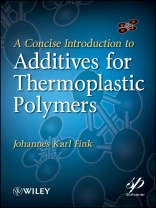Describes twenty-one of the most important and commonly used
additives
A Concise Introduction to Additives for Thermoplastic
Polymers focuses on additives for thermoplastic polymers and
describes 21 of the most important and commonly used additives from
Plasticizers and Fillers to Optical Brighteners and Anti-Microbial
additives. It also includes chapters on safety and hazards, and
prediction of service time models.
While there are many exhaustive and complex books dealing with
additives for polymers, the size of them deter students and many
industry engineers from using them. The purpose of this book,
therefore, is to fill this void and present a concise introduction
to this important subject.
Written in an accessible and practical style, the author
introduces the reader to the complex subject of plastics additives
in an engaging manner. His ability to be concise is the result of
his teaching courses on the subject and using his own lecture notes
for material. This book comprises the author’s course notes so that
a larger public can benefit from his knowledge.
A Concise Introduction to Additives for Thermoplastic
Polymers is the ideal primer for students who will later work
in polymer science or the development of plastics formulation, as
well as industry engineers and specialists who want to have a
deeper knowledge of the plastics industry.
additives
A Concise Introduction to Additives for Thermoplastic
Polymers focuses on additives for thermoplastic polymers and
describes 21 of the most important and commonly used additives from
Plasticizers and Fillers to Optical Brighteners and Anti-Microbial
additives. It also includes chapters on safety and hazards, and
prediction of service time models.
While there are many exhaustive and complex books dealing with
additives for polymers, the size of them deter students and many
industry engineers from using them. The purpose of this book,
therefore, is to fill this void and present a concise introduction
to this important subject.
Written in an accessible and practical style, the author
introduces the reader to the complex subject of plastics additives
in an engaging manner. His ability to be concise is the result of
his teaching courses on the subject and using his own lecture notes
for material. This book comprises the author’s course notes so that
a larger public can benefit from his knowledge.
A Concise Introduction to Additives for Thermoplastic
Polymers is the ideal primer for students who will later work
in polymer science or the development of plastics formulation, as
well as industry engineers and specialists who want to have a
deeper knowledge of the plastics industry.
Tabla de materias
1 Introduction.1.1 Classification.
References.
2 Plasticizers.
2.1 Principle of Action.
2.2 Principle of Selection.
2.3 Characterization.
2.4 Risks and Drawbacks.
2.5 Classes of Plasticizers.
2.6 Specific Examples of Application.
References.
3 Fillers.
3.1 Surface Modification.
3.2 Special Applications.
References.
4 Colorants.
4.1 Physics Behind a Color.
4.2 Color Index.
4.3 Test Standards.
4.4 Pigments.
4.5 Organic Colorants.
References.
5 Optical Brighteners.
5.1 Basic Principles.
5.2 Measurement.
5.3 Inorganic Brighteners.
5.4 Organic Optical Brighteners.
References.
6 Antimicrobial Additives.
6.1 Modes of Action.
6.2 Plasticizers.
6.3 Special Formulations.
References.
7 Flame Retardants.
7.1 Mechanisms of Flame Retardants.
7.2 Smoke Suppressants.
7.3 Admixed Additives.
7.4 Bonded Additives.
References.
8 Lubricants.
8.1 Principle of Action.
8.2 Methods of Incorporation.
8.3 Types of Lubricants.
8.4 Special Applications.
References.
9 Antistatic Additives.
9.1 Types of Additives.
9.2 Areas of Application.
9.3 Additives in Detail.
References.
10 Slip Agents.
10.1 Basic Principles of Action.
10.2 Compounds.
10.3 Special Formulations.
References.
11 Surface Improvers.
11.1 Additives.
References.
12 Nucleating Agents.
12.1 Crystalline Polymers.
12.2 Experimental Methods.
12.3 Classes of Nucleating Agents.
12.4 Crystallization Accelerators.
12.5 Clarifying Agents.
References.
13 Antifogging Additives.
13.1 Field of Use.
13.2 Principles of Action.
13.3 Conventional Compounds.
13.4 Compounds for Grafting.
References.
14 Antiblocking Additives.
14.1 Examples of Uses.
References.
15 Hydrolysis.
15.1 Hydrolytic Degradation.
15.2 Polymers.
References.
16 Dehydrochlorination Stabilizers.
16.1 Dehydrochlorination of PVC.
16.2 Stabilizers.
16.2.1Alkyl Tin Compounds.
References.
17 Acid Scavengers.
17.1 Acid Scavenging.
17.2 Examples of Formulation.
References.
18 Metal Deactivators.
18.1 Action of Metals in Polymers.
18.2 Usage.
18.3 Examples of Metal Deactivators.
References.
19 Oxidative Degradation.
19.1 Autoxidation.
19.2 Inhibition of Autoxidation.
References.
20 Degradation by Light.
20.1 Photolysis.
20.2 Photooxdation.
20.3 UV Stabilizers.
References.
21 Blowing Agents.
21.1 Blowing Agents.
21.2 Ozone Depletion Potential.
21.3 Test Methods.
21.4 Special Applications.
References.
22 Compatibilizers.
22.1 Estimation of Compatibility.
22.2 Compatibilizers.
22.3 Special Examples.
References.
23 Prediction of Service Time.
23.1 Accelerated Aging.
23.2 Theory of Critical Distances.
23.3 Monte Carlo Methods.
23.4 Issues in Matrix Composites.
References.
24 Safety and Hazards.
24.1 Plasticizers.
24.2 Flame Retardants.
24.3 Antifogging Agents.
24.4 Other.
References.
Index.
Acronyms.
Chemicals.
General Index.
Sobre el autor
JOHANNES KARL FINK is Professor of Macromolecular Chemistry at Montanuniversität, Loebem Austria. His career spans more than 30 years in the fields of polymers, including characterization, flame retardancy, and pyrolysis of polymers.
Idioma Inglés ● Formato PDF ● Páginas 282 ● ISBN 9780470624234 ● Tamaño de archivo 10.1 MB ● Editorial John Wiley & Sons ● Publicado 2010 ● Edición 1 ● Descargable 24 meses ● Divisa EUR ● ID 2321180 ● Protección de copia Adobe DRM
Requiere lector de ebook con capacidad DRM












